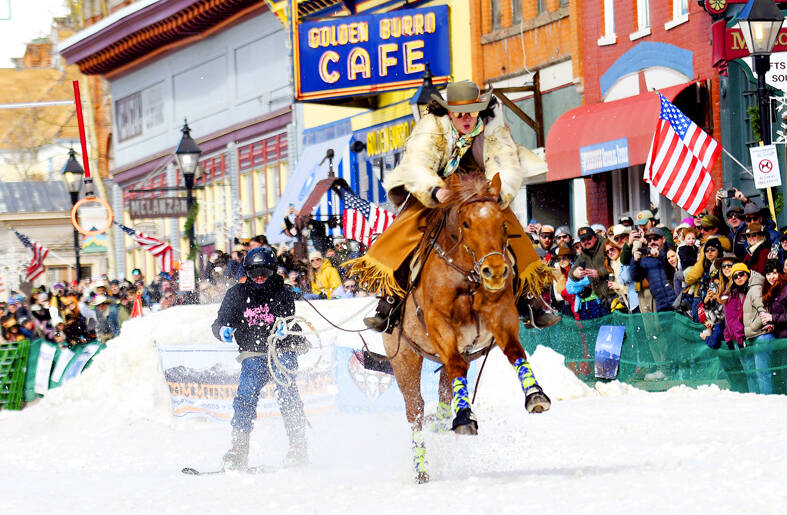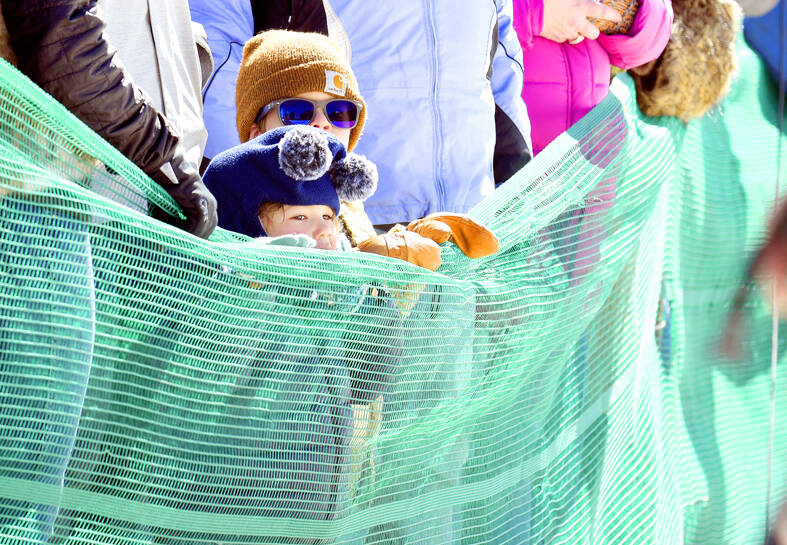Nick Burri clicks into his ski bindings, squats to stretch his knees and scans the snowy race course. Moments later, he is zipping past a series of gates at high speed and hurtling off jumps.
However, it is not gravity pulling him toward the finish line: It is the brute force of a quarter horse named Sirius.
Welcome to skijoring: an extreme — and quirky — winter sport that celebrates the unlikely melding of rodeo and ski culture in the US mountain west.

Photo: AP
It is a heart-pumping, white-knuckle competition in which horses — and sometimes dogs, snowmobiles and even cars — tow skiers by rope at speeds that can top 64kph over jumps as high as 2.4m and around obstacles as they try to lance suspended hoops with a baton, typically a ski pole that is cut in half.
Every winter, thousands of people converge on the old mining town of Leadville, Colorado, high in the Rocky Mountains — elevation 3,096m — lining downtown’s main street and packing the saloons to witness one of the most popular skijoring races in the country.
The spectacle, billed as “The Granddaddy of ’em All,” has been a tradition there since 1949.

Photo: AP
“It’s just the pure adrenaline that gets me to do it... And then getting these two different groups of people together with the riders and the skiers. Usually they don’t hang out, and getting them together, we mesh pretty well,” said Burri, who wears fringed leather pants with his ski gear in a nod to the sport’s western vibe.
Skijoring draws its name from the Norwegian word skikjoring, meaning “ski driving.” It started as a practical mode of transportation in Scandinavia and became popular in the Alps around 1900.
Today’s sport is inherently dangerous, and injuries are not uncommon among riders and skiers alike. Indeed, one of the first riders in the Leadville race earlier this month toppled off his horse and had to be helped off the track as he shook his head in confusion.
Burri did well in the competition despite skiing with a separated shoulder from a hard spill during a race two weeks earlier.
“Wrong turn, taking a jump wrong, go down wrong. You could end your season. Then hospital bills rack up, but it’s just for the thrill of it,” said Burri, a 26-year-old from Meeker, Colorado.
Another skier, Jason Decker, pulled out of the race at the last minute because he broke his collarbone in a crash during a recent contest. He sometimes wears a protective cup, a valuable lesson learned after being hit in the groin by a flying chunk of snow flung by a horse’s hoof.
“It’s not uncommon that my hands are shaking a little bit even after all this time, because that horse’s nostrils are flaring and I’m about ready to grab a rope that’s attached to that saddle. And if I’m not ready to go, then things can go bad real quickly,” said Decker, a 43-year-old engineer from Pagosa Springs, Colorado, who has been skiing since he was two and skijoring for 14 years.
Savannah McCarthy, a competitive skijorer since she was 12, describes a similar nervous energy before she mounts her horse for a race, but once she is speeding down the course, her world goes silent.
“I don’t hear a thing when I’m running,” she said. “When it’s happening, you really don’t have time to think about anything, but when you get done, you’re like: ‘Holy cow, that was insane,’” said McCarthy, a 24-year-old financial broker from Durango, Colorado, who has won the Leadville race nine times.
One of her more memorable moments was when her horse slipped, pulled back and head-butted her, breaking her nose. Then there was the time she lost control of her horse following a race and smashed into a minivan.
Riders and skiers say those moments — the crashes, the speed, the raucous crowd and the camaraderie — make skijoring what it is. And the sport is growing.
Loren Zhimanskova, chair of Skijor USA, which promotes the sport and helps organize races across the country, said skijoring is becoming more mainstream with the rise of social media, and she hopes it will one day be featured in the Winter Olympics.
Skijoring is particularly popular in Poland and Switzerland, as well as in Colorado, Wyoming and Montana in the US.
Five years ago, about 350 riders and the same amount of skiers were competing in the US, she said. Now, there are more than 1,000 competitors in each of those categories, and the number of races has increased from about 15 a year to more than 30.
Despite its growing popularity, getting the sport into the Olympics has proved challenging.
There is no official governing body, no uniform set of rules and regulations and no point system that would allow riders to advance to the Winter Games.
Plus, every track is different, and every race has its own unique traditions and sometimes stubborn organizers.
Still, Zhimanskova is pushing to include skijoring as a non-competitive demonstration sport or to be included in the torch relay at the 2034 Winter Olympics in Salt Lake City.
“I think it’s one of the most romantic and visually pleasing sports that you could see. It’s just magnificent,” she said. “Everyone loves snow ... and then you add horses to that. And then you add cowboys and cowgirls to that. And then you add skiing to that and bonfires and fun music. I mean, all the elements that go into a skijoring event, in my opinion, are really feel-good elements.”

Shohei Ohtani and Clayton Kershaw on Friday joined their Los Angeles Dodgers teammates in sticking their fists out to show off their glittering World Series rings at a ceremony. “There’s just a lot of excitement, probably more than I can ever recall with the Dodger fan base and our players,” manager Dave Roberts said before Los Angeles rallied to beat the Detroit Tigers 8-5 in 10 innings. “What a way to cap off the first two days of celebrations,” Roberts said afterward. “By far the best opening week I’ve ever experienced. I just couldn’t have scripted it any better.” A choir in the

After fleeing Sudan when civil war erupted, Al-Hilal captain Mohamed Abdelrahman and his teammates have defied the odds to reach the CAF Champions League quarter-finals. They are today to face title-holders Al-Ahly of Egypt in Cairo, with the return match in the Mauritanian capital, Nouakchott, on Tuesday next week. Al-Hilal and biggest domestic rivals Al-Merrikh relocated to Mauritania after a power struggle broke out in April 2023 between the Sudanese army and a paramilitary force. The civil war has claimed tens of thousands of lives and displaced more than 12 million people, according to the UN. The Democratic Republic of the Congo-born Al-Hilal

Shohei Ohtani, Teoscar Hernandez and Tommy Edman on Thursday smashed home runs to give the reigning World Series champions the Los Angeles Dodgers a 5-4 victory over Detroit on the MLB’s opening day in the US. The Dodgers, who won two season-opening games in Tokyo last week, raised their championship banner on a day when 28 clubs launched the season in the US. Dodgers manager Dave Roberts shuffled his batting lineup with all four leadoff hitters finally healthy as Ohtani was followed by Mookie Betts, then Hernandez and Freddie Freeman in the cleanup spot, switching places with Hernandez. “There’s a Teoscar tax to

Matvei Michkov did not score on Monday, but the Philadelphia rookie had a hand in both goals as hosts the Flyers earned a 2-1 victory over the Nashville Predators. Ryan Poehling and Jamie Drysdale got the goals for the Flyers (31-36-9, 71 points), who won their third straight. Michkov and Travis Konecny assisted on both. Ivan Fedotov stopped 28 shots to earn his first win since March 1, ending a personal six-game losing streak. Zachary L’Heureux got the lone goal for Nashville. Michael McCarron and Brady Skjei got the assists for the Predators (27-39-8, 62 points), who have just four goals in their